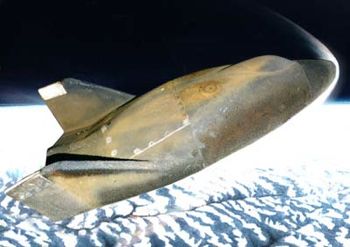
Home - Search - Browse - Alphabetic Index: 0- 1- 2- 3- 4- 5- 6- 7- 8- 9
A- B- C- D- E- F- G- H- I- J- K- L- M- N- O- P- Q- R- S- T- U- V- W- X- Y- Z
Prime
 Prime Credit: USAF |
AKA: SV-5D;X-23A. Status: Operational 1966. Gross mass: 405 kg (892 lb). Height: 2.10 m (6.80 ft). Span: 1.20 m (3.90 ft).
The purpose of START was to develop and demonstrate the technology for maneuvering lifting-body re-entry vehicles with a cross range of up to 1100 km. Planned applications included ICBM warheads, reconnaissance satellite film recovery capsules, and manned spacecraft. The X-23 Prime was a subscale re-entry test vehicle of the SV-5D lifting body configuration planned for the X-24A manned aerodynamic test aircraft. In three suborbital launches the robot vehicle demonstrated the full planned cross range maneuver, and the problems involved in using spray-on ablative heat shields.
Lifting bodies were originally conceived for use as maneuverable ICBM re-entry vehicles to defeat Soviet anti-ballistic missile systems, and as high cross-range film-return capsule for reconnaissance satellites that would improve quick response by providing more film recovery opportunities. NACA's Ames laboratory was the place where much early research was done, resulting in the M2b, M2F2, and M2F3 series of flight demonstration vehicles. NACA Langley had its differing HL-10 design, and the USAF developed the Aerospace Corporation A3 shape for its own specific cross-range requirement. In November 1960 Martin was contracted to study use of the Ames M1 shape for recovery of film capsules from the USAF Samos satellite. Instead it concluded that the Aerospace A3 configuration was superior, and developed a stretched version of the A3 as the A3-4 or SV-5. Tests of the SV-5 under the PRIME project were to include demonstration of 1145 km cross-range maneuvers. After the cancellation of DynaSoar, the remaining Asset subscale re-entry tests of that program were combined with PRIME, resulting in Air Force Program 680A, called START, and consisting of subprojects Asset, Prime, and Pilot (subsonic piloted lifting-body tests).
The Prime X-23A lifting body weighed 400 kg and was built primarily of 2014-T6 titanium alloy, with some structures built of beryllium, steel, or aluminum, as required. On a typical flight, the unmanned SV-5D was launched by an Atlas booster from Vandenberg AFB, California. At the high point in its flight path, the Atlas pitched downward while its rocket continued accelerating it to orbital re-entry velocity. The lifting body separated from the booster, and its inertial guidance system directed it to a pre-selected recovery point. Outside the earth's atmosphere the SV-5D was maneuvered by the release of high pressure nitrogen through jet thrusters. When the craft re-entered the atmosphere its control system automatically switched to airplane-type flaps for pitch and roll control. The shape was expected to demonstrate a hypersonic L/D of 1.0. Two types of ablative coating protected the vehicle during re-entry. Silicon-nylon fibers within an ablator applied to a silicon honeycomb base protected the main body of the shape. Thickness varied from 2 to 7 cm depending on the expected heating rates. The nose cap was protected with a carbon-phenolic resin. The lifting portion of the re-entry would be terminated at Mach 2.0 with deployment of a drogue ballute, followed at subsonic speeds by a 14-m diameter recovery parachute. Air-snatch of the re-entry vehicle under its parachute was to be accomplished by a JC-130B aircraft over the ocean.
After the successful third mission, the rest of the project was cancelled, and the two remaining unflown X-23A's were sent to the USAF Museum at Wright Patterson Air Force Base. After the cancellation of Dynasoar, the Air Force pursued further development of manned spaceplanes under the START Project.
Structure: 78 kg (171 lb). Heat shield: 110 kg (240 lb). RCS Coarse No x Thrust: Cold gas (nitrogen).
More at: Prime.
Family: Spaceplane, Suborbital, US Rocketplanes. Country: USA. Launch Vehicles: Atlas. Agency: Martin. Bibliography: 152, 158, 22, 44, 48.
 | Prime Credit: Manufacturer Image |
 | X-24A Credit: © Mark Wade |
1965 March 3 - .
- X-24 maneuverable reentry vehicle announced as a follow-on to the ASSET spaceplane. - .
Related Persons: Schriever.
Spacecraft: Asset,
X-24,
Prime.
General Bernard A. Schriever, Commander, AFSC, announced plans to develop a wingless, maneuverable reentry vehicle (SV-5) as a follow-on to the ASSET spaceplane. The new vehicle was under Space Systems Division management and was part of the new Precision Recovery Including Maneuvering Reentry (PRIME) program. Both PRIME and the ASSET programs were part of the larger Spacecraft Technology and Advanced Reentry Test (START) program.
1966 February 11 - .
- PRIME and PILOT reentry vehicle plans approved. - .
Spacecraft: Asset,
X-24,
Prime.
Headquarters USAF informed AFSC that both the Precision Recovery Including Maneuvering Reentry (PRIME) and PILOT low-speed reentry vehicle program development plans had been approved. PRIME, PILOT, the Aerothermodynamic/ Elastic Structural Systems Environmental Tests (ASSET) program, and Advanced Maneuvering Entry were all new projects within the Spacecraft Technology and Advanced Reentry Tests (START) program managed by Space Systems Division.
1966 April 26 - .
- SV-5P manned lifting-body vehicle begun. - . Spacecraft Bus: X-24. Spacecraft: Prime. The SV-5P was to be developed as the Piloted Low-Speed Test (PILOT) portion of the Spacecraft Technology and Advanced Reentry Test (START) program managed by SSD..
1967 May 12 - .
- Fourth PRIME flight cancelled. - . Spacecraft Bus: X-24. Spacecraft: Prime. Headquarters USAF instructed Headquarters AFSC to cancel the fourth planned Precision Recovery Including Maneuvering Entry (PRIME) flight..
Back to top of page
Home - Search - Browse - Alphabetic Index: 0- 1- 2- 3- 4- 5- 6- 7- 8- 9
A- B- C- D- E- F- G- H- I- J- K- L- M- N- O- P- Q- R- S- T- U- V- W- X- Y- Z
© 1997-2019 Mark Wade - Contact
© / Conditions for Use